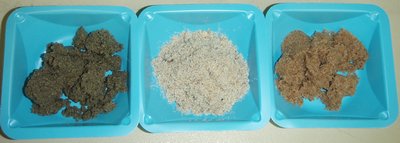 Research Areas > Beach Water Quality > Evaluating Methods to Measure Fecal Indicator Bacteria (FIB) in Sand
Research Areas > Beach Water Quality > Evaluating Methods to Measure Fecal Indicator Bacteria (FIB) in Sand
Project: Evaluating Methods to Measure Fecal Indicator Bacteria (FIB) in Sand
Background and Objectives
Persistence and/or growth of fecal indicator bacteria (FIB) in beach sand and sediment are potential sources of contamination to recreational waters. While there have been a number of studies on this topic, there is no widely accepted method to recover and enumerate FIB in sand. Published methods to extract bacteria from sand range from simply shaking the sample by hand to carrying out complex protocols that involve use of sonication, mechanical shakers, and sophisticated buffers.
There have been no studies that compare these method variations, providing little basis for researchers to select a method or to determine whether data from different studies are comparable. It is also unknown whether the preferred recovery method varies among different sample types. For example, hand shaking may be adequate for recovering FIB from coarse beach sand, but inadequate for samples with a high level of silt, clay or organic material. The purpose of this study was to compare and evaluate the parameters within existing methods and establish a scientifically-defensible agreed-upon method for recovering and enumerating FIB from beach sand.
Status
This study was completed in 2009.
Methods
The study involved processing replicate samples using 20 different method permutations, and comparison of the bacterial recovery rates. Each treatment was performed in quadruplicate, with two replicates processed by each of two different researchers, allowing quantification of variability both within-method and among-personnel.
Methods tested included those based on sonication, blending and shaking. Shaking is currently the most commonly used method. The study involved varying the following parameters:
1) Duration and intensity of shaking: There is wide variation among practitioners in the amount of shaking and whether it is done by hand or using a mechanical shaker.
2) Sample weight: The weight of sand/sediment used in the predominant published methods varies from 3-50 grams. Differences in sample weight could affect bacterial recovery rates.
3) Type of eluant: While some researchers use only sterile deionized water to elute FIB, others use PBS or add surfactants or metaphosphate to help dislodge particle-bound bacteria.
4) Amount of settling time prior to analysis: The amount of time elapsed between mechanical shaking and withdrawing a sample for FIB analysis could affect the size of particles settling out of the solution. Because bacteria may still remain attached to some particles, their settling out of solution could affect the bacterial concentration measured in the supernatant.
5) Number of rinse steps: Successive rinse steps after shaking/sonication may transfer additional bacteria from particles to supernatant and provide additional removal of interstitial bacteria.
6) Pre-filtration: Pre-filtration is sometimes used to remove particles from shaken eluant prior to performing membrane filtration. While this step is helpful in producing countable plates, its effect on the number of colonies produced or the percentage of bacteria trapped on the filter is unknown.
All 20 treatments were applied to three samples: (1) silicate sand from a marine environment (southern California), (2) silicate sand from a freshwater environment (Great Lakes), and (3) carbonate sand from a marine environment (Miami). All method permutations for a sample were conducted over a four-hour period on a single day, with a single sample being processed on each of three consecutive days.

Three types of sand used in the study.
Prior to distribution to the participating researchers, each sample was homogenized using a large commercial mixer to ensure uniform distribution of FIB within the sample. The homogenized sample was then placed in a flat-bottomed tub and subsampled by pushing lexan cylinders into the sample to maintain vertical uniformity between samples and minimize differences due to changing levels of pore water. Each researcher was given one (or multiple depending on sample weight required) lexan cylinder that was then emptied into a sterile 250 ml Nalgene wide-mouthed bottle and remixed.
Findings
Results indicated that the simplest method (which also had the highest recovery rates) consisted of two minutes of hand shaking with one rinse step, a 30 second settling time, and a 10:1 eluant volume to sand weight ratio. Eluant composition did not have a significant effect on recovery. Sonication produced equivalent enterococci counts when compared to shaking, though both were significantly higher than the blending approach. Varying most parameters had insignificant effects on enterococci enumeration. In summary, the hand shaking method was simple and robust, and is recommended for monitoring beach sands for enterococci to understand their contribution to poor surface water quality and beach advisories and closures.
Partners
This project was conducted in collaboration with Stanford University, University of Miami, UCLA, US Geological Survey, Environment Canada, Orange County Public Health Laboratory and Orange County Sanitation District.
Tools
Presentation
Evaluation of Methods for Enumerating Enterococci in Beach Sand - January 2009 presentation to SCCWRP member agencies describing method development process and variables for enumerating bacteria in beach sand.

This page was last updated on: 7/2/2014